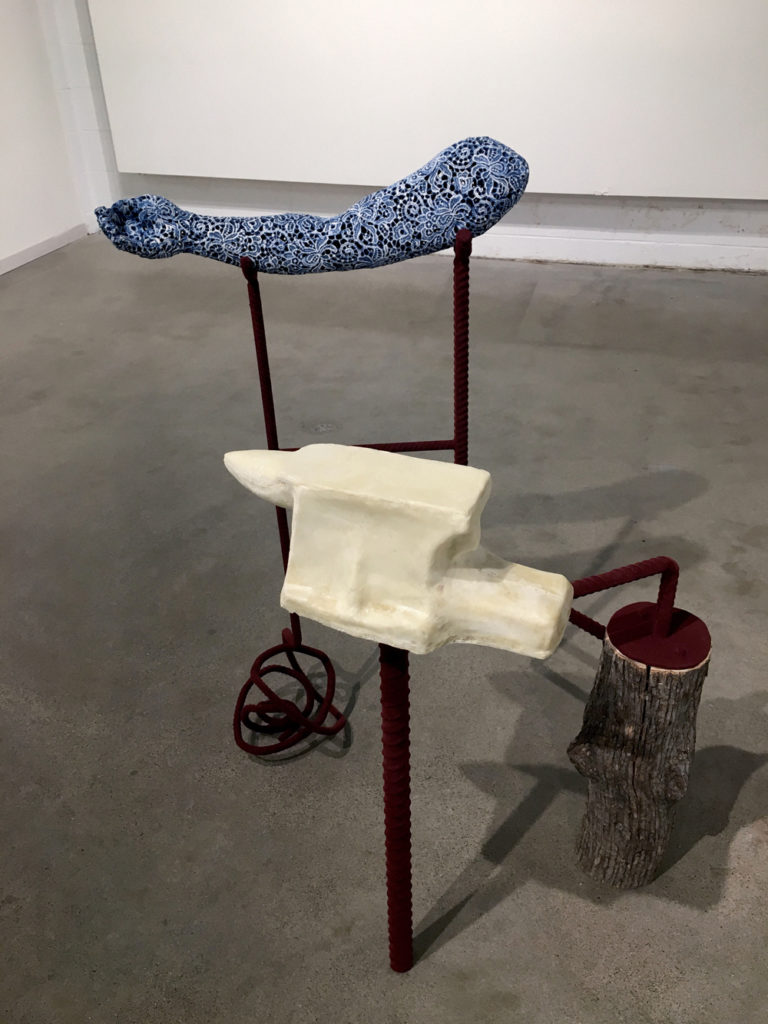Betsy Alwin and Shana Kaplow Uncertain Structures, The Small Parts
Review I by Leia Wambach
Rosalux Gallery
Aug 4–26, 2018

“Uncertain Structures” by Alwin and “The Small Parts” by Kaplow. Their practices are distinct but well matched.
Alwin, a casting specialist, remakes familiar but habitually overlooked objects in materials that negate intended function. Heavy-duty tools and architectural supports become fragile or weightless. An anvil is reborn in foam. Segments of steel beams are madeover in Alwin’s signature ceramic lace. Industrial rebar comes out from inside the walls, re-worked by Alwin into custom mounts that are flocked crimson and twist into vine-like tendrils. The title of the exhibition, “Uncertain Structures”, suggests something barely held together, yet the combined parts of Alwin’s sculptures feel made to cohere. Perhaps the work Life is a Drag would topple were I to pull away its load-bearing branch, but Alwin does not give me the chance to try. The branch is carefully secured and the entire form expertly mounted to the wall. The objects Alwin fabricates out of ceramic lace are the most delicate and also the only forms truly at risk. Their livelihoods depend on the sturdiness of the structures that support them, yet I do not worry. My overall sense is of balance and care, not uncertainty.
One work brings the implications of fragility into sharper focus. In the freestanding floor sculpture titled Lightness of Being, Alwin includes a cast of her own arm. Like the foam anvil also featured in the piece, her arm is a tool habituated to labor. Here she suspends her hard-working limb in the feminine delicacy of lace. She makes it brittle and breakable, precious and unusable. I feel this shift away from utility as a loss, away from an established self. With this work, Alwin reaches into heavy questions about being alive and being worth something within the world. Like objects, people are assigned value—for beauty, for strength, for utility, or novelty. This value is transient, mortal and deeply informed by gender, race and class. What do we do when our assigned worth no longer applies? Do we care about a beam that can’t hold up a building?
Shana Kaplow’s show, “The Small Parts”, grazes against a more perpetual state of absence and ambiguity. In her work Counterpart, Kaplow seeds the ghost that haunts her show. Taped above and right of center, the word “who” manifests an absent, imagined body that gains traction, settling in amidst the empty chairs and forgotten water glasses, captured maybe in the anonymous MRI scans throughout the gallery. My favorite documentation of the ghost, a painting titled In Contrast to Presence, is merely marks and light dabs of ink on paper—the approximated space around something missing. As a viewer, I can’t help but fill the chairs and conjure whatever invisible sickness necessitated MRI scans. In ambiguous absence, the ghost invites bodily intimacy.
Kaplow works primarily in ink on paper. Her trompe-l’œil accuracy is startling, most of all when coupled with her abstract inkscapes. The work Tissue, for example, is a painting in three parts. On top, the worn-in bench, perfectly rendered, below, an uninhibited ink wash that bleeds to the edges of the paper before spiraling out, sandwiched between a curving yellow color field like a stained sheet hung on a line. Kaplow gives us a bench and the inarticulate internal landscape camped around that bench. Combined, the realistic and abstract paintings evoke momentary resonance.
Kaplow’s approach to installation feels informed by the fleeting quality of these crystalline moments. She matches paintings and what seem to be scraps of paintings, mostly installing without frames directly onto gallery walls. Works like Tissue or The Elephant suggest collage, minus the glue that binds. Though several of the works in these groupings could easily stand on their own, many depend upon Kaplow’s knack for arranging and titling. They feel transient, ready to come apart just as easily as they were put together, so much so that I wonder if a grouping like Tissue will survive beyond the run of the show. In Kaplow’s world, as in ours, things seem to align momentarily then scatter or dissolve away.
Kaplow and Alwin’s exhibitions are thematically linked in several ways—most notably for the attention they grant overlooked but load-bearing objects. I see them diverge around the expression of fragility. Alwin creates careful, technical sculptures that keep their vulnerability secret. I find myself with the odd idea that perhaps the lace-cast objects themselves haven’t yet realized that they are fragile. If they knew, wouldn’t they be more worried? In contrast, Kaplow’s works are native to their own impermanence. They may offer moments of clarity, but return to inky ambiguity or are reshuffled into something else. I attribute the difference in part to the artists’ contrasting materials. Alwin’s fired clay makes for a stable but breakable body that requires protection. Kaplow’s ink on paper, the unbreakable ghost.
